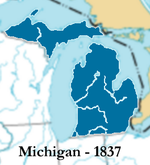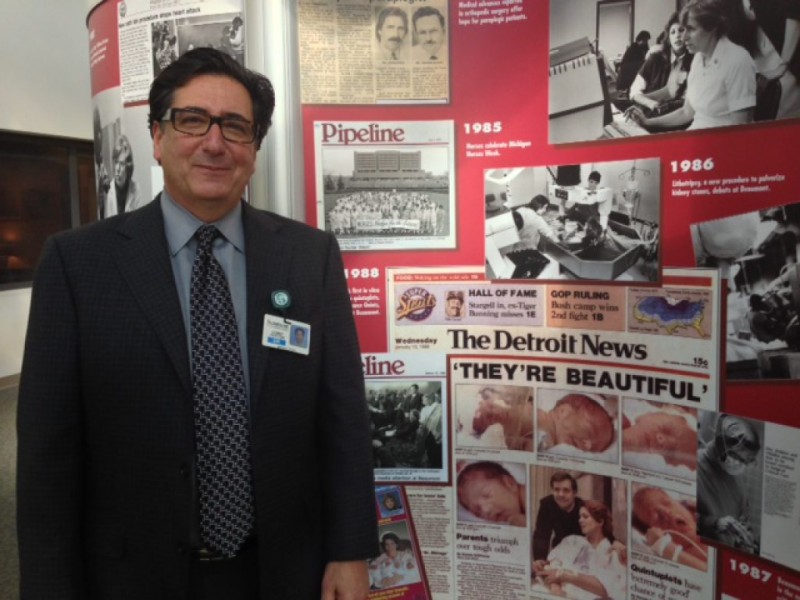On January 11, 1805, President Thomas Jefferson signed an act establishing the Michigan Territory.
When Ohio became a state in 1803, the present-day state of Michigan became part of the Indiana Territory. Since the territorial capital was in Vincennes — a long distance (350 miles and no roads) from Michigan’s population center of Detroit — Michiganders lobbied for their own territory. Communication between the Indiana territorial leadership and Detroit was so poor, that when Gov. William Henry Harrison ordered an election to be held in the territory, the order never reached Detroit and Detroiters never voted.
The law creating the Michigan Territory took effect in July 1805. It included the Lower Peninsula and the tip of the eastern Peninsula. Over the next several years the territory was expanded to include parts of Wisconsin and Minnesota.

Michigan shrank in 1836 with the creation of the Wisconsin Territory. Wisconsin Territory was established in 1836 with the present boundary in the Upper Peninsula.

![]() The disputed portion of Michigan Territory referred to as the Toledo Strip.
The disputed portion of Michigan Territory referred to as the Toledo Strip.
Sources :
Michigan Territory wikipedia entry
The Mitten, a publication of Michigan History magazine.
Michigan is Amazing

On Jan. 11, 1945, Sen. Warren G. Hooper was assassinated only after two weeks in office as a senator. A passer-by happened upon Hooper’s burning Sedan on a rural road near Springport. Inside the vehicle, Hooper lay, shot three times in the head.
Hooper was scheduled to testify before a grand jury the next day as the key witness in a corruption case involving bribes for legislators to influence a horse racing bill. In that same case three grand jury witnesses committed suicide under “suspicious circumstances,” according to a Grand Rapids Press report. Hooper’s death signaled a serious blow to the corruption investigation, and his killer or killers were never discovered.
After Hooper’s death the original bribery investigation snowballed and resulted in 62 convictions, including 23 legislators.
The Hooper murder prompted the publishing of at least three books. The nonfiction books are “Three Bullets Sealed His Lips” and “Payoffs in the Cloakroom, the Greening of the Michigan Legislature 1938-1946” by Bruce A. Rubenstein from the University of Michigan-Flint and Lawrence E. Ziewacz of Michigan State University. Michigan Court of Appeals Judge William C. Whitbeck also penned a new legal thriller, “To Account For Murder”, based on the Hooper murder.
Addendum:
On June 15, 1948, the Michigan Supreme Court ordered three former Purple Gang members to serve prison terms for plotting the state Sen. Warren Hooper murder, although none of the three were convicted of the killing. Myron Selik and brothers Harry and Sam Fleisher lost their appeal on the Calhoun County conviction that they plotted the murder in O’Larry’s Bar in Detroit. Two gunmen testified that they had been offered a cut of a $15,000 pie to kill the Senator, but that they had pulled out of the deal.
Hooper was a star witness in the Carr-Sigler legislative graft grand jury investigation until he was murdered Jan. 11, 1945, as he was driving from Lansing to his Albion home. Despite a $25,000 reward, nobody was ever arrested for pulling the trigger in Hooper’s death’
Sources:
Michigan Every Day by Patrick Sullivan and Carole Everly, Eberly Press, 2009.
Emily Lawler, “Death, Drugs, and Skullduggery : A Brief History of Michigan Political Scandals“, MLive, August 21, 2015; updated August 24, 2015.
Brad Flory, “Graft, gangsters and Jackson County’s most notorious unsolved murder”, MLive, January 9, 2015.
Leanne Smith, “Peek Through Time: Politician’s shooting death in 1945 is still a mystery”, MLive, February 12, 2011.
“On the senator who stood up to the Purple Gang – and lost”, including a cover from the newspaper.
“Poster a Reminder of Hooper Mystery”, Albion Recorder, Monday, October 19, 1998, pg. 4.
Ziata Meyer, “State senator about to testify on corruption is killed”, Detroit Free Press, January 8, 2011.
Michigan Appeals Judge William Whitbeck’s new novel, To Account for Murder, has renewed interest in the Hooper case.
Detroit Free Press
On January 11, 1955, a presentation at the Society of Automotive Engineers in Detroit advanced an unpleasant theory about automobiles.
A team of scientists gave the engineers something to think about when they said tests showed that auto exhaust combined with sunlight were leading to an increase in smog.
Source: Lansing State Journal
Attempts to weaken the opposing political party’s power are nothing new in Michigan.
On Jan. 11, 1960, Michigan Democratic leaders proposed a plan to abolish the state Senate. These recommendations were proposed by a Legislative Reform Subcommittee led by then-Rep. Ralph Richman (D-Holland), and appeared to be aimed at decreasing the power of Republican lawmakers.
Sen. Harold Ryan (D-Detroit) was the only senator involved in the subcommittee and the only legislator in the subcommittee to oppose the plan.
Source : Detroit Free Press and MIRS, January 11, 2010.

Bailey Sisoy Isgro sits at the parlor table in her home, which she’s renovating for her business, Detroit History Tours.
On January 11, 1987, somewhere in what is now Hutzel Women’s Hospital, Bailey Sisoy Isgro came squalling into the world.
Many years later, Isgro started Detroit History Tours.
“When (my partner and I) started this, we thought we might do four tours a year,” Isgro said. “Last year we did 117.”
The events and tours are designed for entertainment as much as edification. Wild Women of Detroit takes bus riders on a cruise around town to see the haunts of “broads, women, cats, ladies and Rosies.” Cops and Mobsters looks into Detroit’s rich history of organized crime. At the house, a Valentine-themed event presents a dessert tasting, along with looks at several speakers’ “historic crush,” and on some Saturdays there’s a brunch with “Interesting People Reading Interesting Things,” which Isgro calls “storytime for adults.”
“People are really interested in Detroit history,” Isgro said. “And they want to have a good time doing it.”
Source: Nancy Derringer, “How one businesswoman is drawing inspiration from a legendary madam“, Bridge, February 1, 2017.

Helen McGowan published her memoir, “Motor City Madam,” in 1964.
On January 11, 1987, somewhere in what is now Hutzel Women’s Hospital, a woman once known as Detroit’s top madam died from complications of a stroke. She was 75. Her name was Helen McGowan.
The name Mae Abisher might not be familiar to Michiganders, and there are very few who know her “professional” name: Helen McGowan.
Mae was Missouri-born in 1911, growing up in a poverty-stricken family in the town of Malden. Her desire to break away from her strict father (who beat her for reading books like “Robinson Crusoe” and other classics) led to her pregnancy at 15 years old with a local farm boy.
A literal shotgun wedding was performed, and after sullenly saying “I do”, the baby’s father proceeded to slug Mae in the mouth, then he hopped a train, and was never heard from again. What a memorable wedding day.
Not wanting to go to her parents’ home, Mae moved in with an African-American lady who helped take care of her during the pregnancy. The woman, named Ruth, told Mae something that she never forgot: “When a girl makes a mistake, they knocks her down for it. When a boy does it, all they say is boys will be boys. It ain’t fair but that’s what happens”.
The baby was born, given to another couple, and Mae’s mother sent her to Flint, Michigan to live with her sister Rita…..which didn’t go well. Going to work in a shop, co-workers found out about her past which led to arguments and fights. Not only that, but Rita’s husband began making sexual advances toward her. Mae turned him down, and in return, she was kicked out with no place to live.
In the next few years Mae moved to Kansas City and Chicago, where she became familiar with Al Capone. She ended up working at Capone’s Cotton Club, thanks to a tip by a friend whose name happened to be…..John Dillinger. Not long afterward, in 1927, sixteen-year-old Mae packed up and went back to Michigan, this time to Detroit.
Mae discovered that the Detroit population was mostly male, and that was where the money would be. She decided to take up prostitution and changed her name to “Helen McGowan”. She became successful enough – and wise in the business aspect of prostitution – that later she took on the role of brothel madame.
She made sure her girls made frequent trips to doctors, she charged less than other houses, and adjusted rates for those not as wealthy as her professional clients. Lawyers, doctors, politicians…so-called “respected” citizens paid repeated visits to Helen’s houses. In her book, Motor City Madam, she wrote “Although lawyers, doctors and many other professional men frequent my parlors, the majority of callers are from the working class, the one-hundred-dollar-a-week boys. I charge a fair price, well within the means of the lonely employed worker”.
Nicknamed “Rocking Chair Helen”, thanks to her fondness to relax in her favorite rocking chair, Helen moved around, renting place-to-place, many times having as many as 30 places in one year. She not only told her own personal story, but she also gave the dark side, where many of her girls ended up in a whirling morass of drug, alcohol, and heroin addiction…and death. All this and more is found in her book, which is extremely hard to find.
Sources:
Helen McGowen, Motor City Madam, New York : Pageant Press, Inc., 1964. available at the Library of Michigan.
Nancy Derringer, “How one businesswoman is drawing inspiration from a legendary madam“, Bridge, February 1, 2017.
John Robinson, The “Motor City Madame” of Michigan”, 99.1 WFMK Blog, December 16, 2020.
Dr. Lenny Hutton had been in practice for four years in 1987 when the in-vitro fertilization (IVF) program at Beaumont Hospital in Royal Oak referred a 34-year-old woman expecting quintuplets—make that America’s first test-tube quintuplets.
“I was a little stunned when she showed up in my office with the pictures of five viable babies with five heartbeats,” Hutton, 59, said.
Michele L’Esperance, a social worker and former model, conceived the babies with the help of Dr. S. Jan Behrman, chairman of Obstetrics and Gynecology at Beaumont. Behrman, known as the grandfather of reproductive endocrinology, had gone to England to learn the IVF procedure and brought it back to the Midwest, Hutton said.
On Jan. 11, 1988 Hutton attended a Monday night dinner program at a local restaurant when he received a phone call from the hospital.
“As I left the restaurant I told the maître d’, ‘What I am about to do, you’re going to read about in the paper tomorrow.”
Hutton said they choreographed the delivery like a ballet.
“We had to practice because we knew we couldn’t go by the seat of our pants with five,” he said. “We needed five bassinets, five neonatologist, five teams of nurses—five of everything. We practiced how we were going to hand them off and what room they would go to.”
Source: Judy Davids, “It’s Been 25 Years Since L’Esperance Quintuplets Made History in Royal Oak;Beaumont doctor fondly recalls delivering America’s first test-tube quintuplets“, Royal Oak Patch Community Paper, March 19, 2013; updated March 22, 2013.

To mark the 100th anniversary of the Department of State Police, starting Wednesday, 50 special edition black and gold patrol cars joined the department’s patrol fleet.
The 2016 Dodge Chargers are painted to look like the department’s 1937 Ford Model 74 patrol car. The department used black and gold patrol cars until 1954 when they switched to bright blue still in use today.
Each of the department’s 30 posts will receive at least one of the special edition vehicles for use on general patrols and at community events. In a statement, the department said the vehicles were purchased as part of its annual fleet replacement program so no additional money was spent than would otherwise have been expended. The vehicles will remain in the department’s fleet until they reach their maximum mileage like all other patrol cars.
For more information about the MSP’s 100th Anniversary, visit www.michigan.gov/MSP or follow the conversation on social media using #MSP100.
Source : “Black and Gold Patrol Cars Coming to State Police Fleet for 100th Anniversary“, Michigan Newswire, January 10, 2017.
As January 11th is ‘Milk Day,’ here’s a few MI milk facts. Over 97% of all dairy farms here are family owned with an average herd has about 176 cows. The typical Michigan cow will produce over 2860 gallons a year; in fact Michigan produces enough milk for the entire state plus enough extra to export to other states!
Note: Some celebrate World Milk Day on June 1st instead to kick off June Dairy Month.
Sources:
Michigan Historical Review Facebook Page.
Celebrate World Milk Day, Michigan Farm News, August 1, 2018
Gus Ganakas, former MSU basketball coach, died today at the age of 92. One of MSU’s all time great athletic ambassadors.
Ganakas was the head coach for the Spartans from 1969-76. His best season with the Spartans was in the 1974-75 season when State went 17-9 overall and 10-8 in Big Ten play, good for fifth in the Big Ten.
Ganakas was the lead radio analyst for Michigan State basketball for more than three decades, and was an ambassador for the program for the rest of his life.
Before taking the MSU job, Gus was the head boys basketball coach at East Lansing High School, leading the Trojans to an undefeated season and a state title in 1958.
Source : Tim Staudt.






